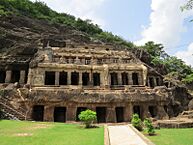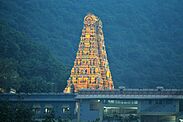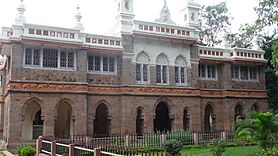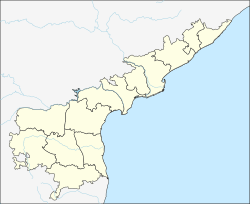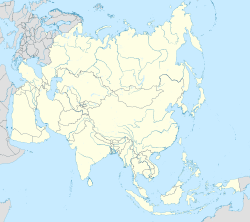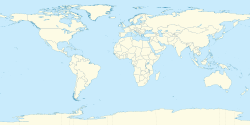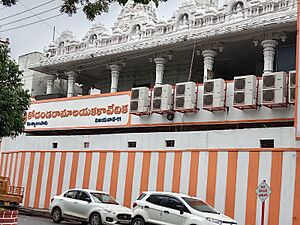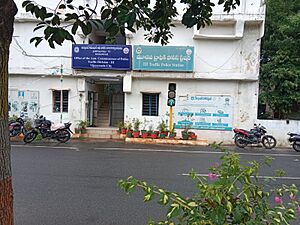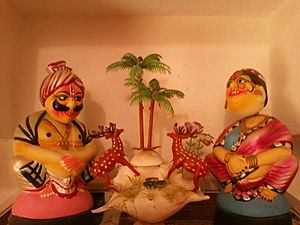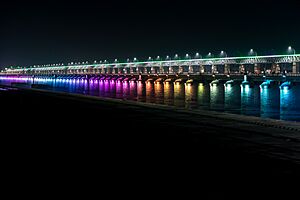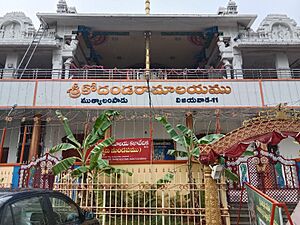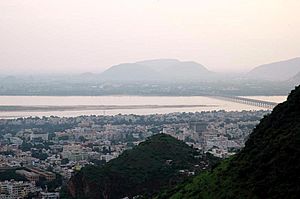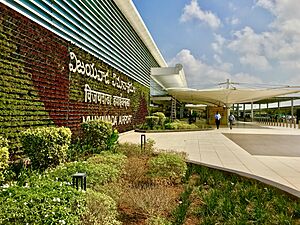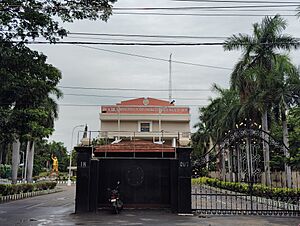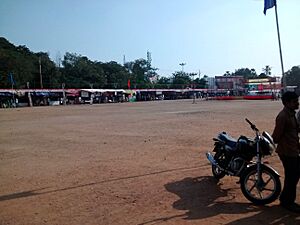Vijayawada facts for kids
Quick facts for kids
Vijayawada
Vijayawāḍa (Telugu)
Bezawada
|
|
|---|---|
|
Clockwise from top: Prakasam Barrage, Statue of Social Justice, Kondapalli Fort, Undavalli Caves, Kanaka Durga Temple, Gandhi Smaraka Stupam, and Bapu Museum
|
|
| Etymology: The Place of Victory | |
| Nickname(s):
City of Victory
|
|
| Country | |
| State | Andhra Pradesh |
| Region | Coastal Andhra |
| District | NTR |
| Incorporated (Municipality) | 1 April 1888 |
| Incorporated (Corporation) | 6 June 1981 |
| Government | |
| • Type | Municipal Corporation |
| • Body |
|
| Area | |
| • Urban | 283.58 km2 (109.49 sq mi) |
| • Metro | 8,603.32 km2 (3,321.76 sq mi) |
| • City | 61.88 km2 (23.89 sq mi) |
| Elevation | 11 m (36 ft) |
| Population | |
| • Rank | 2nd (in Andhra Pradesh) and 27th in India |
| • Urban | 1,230,000 |
| • Urban density | 4,337/km2 (11,230/sq mi) |
| • Metro | 6,800,000 |
| • City | 1,230,000 |
| Literacy | |
| • Literates | 980,000 |
| • Literacy rate | 84.5% |
| Languages | |
| • Official | Telugu |
| Time zone | UTC+05:30 (IST) |
| PIN |
520001
|
| Area code(s) | +91–866 |
| Vehicle registration | AP 39, AP 40 |
| Nominal GDP (2023–24) | ₹48,000 crore (US$8.2 billion) |
| International Airport | Vijayawada Airport |
| National Highways | NH 16, NH 65, NH 30 |
Vijayawada (pronounced Vijay-uh-waw-duh), once known as Bezawada, is a big city in the Indian state of Andhra Pradesh. It's the second largest city and a major business center. Vijayawada is part of the Andhra Pradesh Capital Region. It sits by the Krishna River, with the Eastern Ghats and Indrakeeladri Hills nearby.
The city is famous for the Kanaka Durga Temple. This important Hindu temple brings in millions of visitors every year. Vijayawada is located near the center of the state. It is often called the business, political, cultural, and education hub of Andhra Pradesh. It is also the main office for the new NTR district. The Prakasam Barrage on the Krishna River is a key structure. It connects NTR district with Guntur district.
Vijayawada is one of India's fastest-growing cities. An Oxford Economics report even listed it among the top 10 fastest-growing cities worldwide. It is seen as a sacred place because of the Kanaka Durga Temple. This temple, dedicated to the Hindu Goddess Durga, is on Indrakeeladri Hill. The city also hosts the Pushkaram festival for the River Krishna.
An old story says that Arjuna, a hero from the Indian epic Mahabharata, prayed on Indrakeeladri Hill. He received blessings from Lord Shiva to get a special weapon called the Pashupatastra. This helped him win the Kurukshetra War. The city was called Vijayavatika, meaning "Land of Victory" in Telugu. This name came after Goddess Durga defeated the demon Mahishasura and rested on Indrakeeladri Hill. "Vijaya" means victory, and "Vatika" means place or land.
Vijayawada is one of the most crowded urban areas in the world. It is also a "Y-grade" city, which is a classification for Indian cities. It is the second most populated city in Andhra Pradesh, with over a million people. McKinsey Quarterly called it a "Global City of the Future." They predicted its economy would grow to $17 billion by 2025. In October 2018, it received a high-level certification (ISO 37120) and joined the "Global Cities Registry."
Because of its many good schools, Vijayawada has become a major education center. Many students from across the country study here. An Oxford Economics report predicts it will be the world's tenth fastest-growing city economy by 2035. It was ranked India's ninth most livable city in 2018. This was due to its high scores in entertainment, construction, food, education, health care, and transport. It was also the second most livable city in Andhra Pradesh.
The Vijayawada Junction railway station is one of the busiest in India. It is the tenth busiest railway junction in the country.
Contents
What's in a Name?
There are many stories about how Vijayawada got its name. One legend says that Goddess Durga defeated the demon Mahishasura and then rested here. Because she was victorious, the place became known as Vijayawada. "Vijaya" means victory, and "wada" means place. So, it means "The Place of Victory." The hill was called Indrakeeladri because Indra, a powerful god, often visited it.
The epic story Mahabharata also mentions Indrakeeladri hills. It says this is where Arjuna received the special weapon Pashupatastra from Lord Shiva. Since one of Arjuna's names is "Vijaya" (meaning invincible), the city was later called Vijayavatika. "Vatika" means place in Telugu. This name then changed to Vijayawada.
Another story explains the name Bezawada. Goddess Krishnaveni (the Krishna River) asked Arjuna to make a path for her to flow into the Bay of Bengal. Arjuna made a "bejjam" (hole) through the mountains. So, the place was called Bejjamwada, which later became Bezawada. In the 12th century CE, Vijayawada was also known by other names like Vijayavata, Beejapuram, and Kanakapuram.
A Look at History
Vijayawada, then called Bezawada, was founded around 626 A.D. by the Paricchedi Kings. History shows that King Madhava Varma, from the Vishnukundina dynasty, ruled Bezawada. A Chinese Buddhist scholar named Xuanzang lived in Bezawada around 640 A.D. He spent several years studying and copying Buddhist scriptures.
The Mogalrajapuram hills have five temples carved into rocks. These were built between the 4th and 9th centuries. Some of these caves are linked to the Vishnukundina dynasty. The Akkana Madanna Caves, at the foot of Indrakeeladri Hill, are a very important historical site.
At the base of Indrakeeladri hills is the Malleswara temple. This temple has writings from the 9th to 16th centuries by different kings. There are ten pillars and a damaged stone slab with writings in the Telugu language. The writings from Yudhamalla I and II of the Eastern Chalukyas are especially important.
In the early 16th century, during the rule of the Qutb Shahi dynasty, diamond mines were discovered near Vijayawada. These mines were located on the banks of the Krishna River.
Where is Vijayawada?
Vijayawada is located on the banks of the Krishna River. It is surrounded by hills and canals. The city is about 11 meters (36 feet) above sea level. Three canals start from the north side of the Prakasam Barrage reservoir. These canals—Eluru, Bandar, and Ryves—flow through the city.
Weather in Vijayawada
Vijayawada has a tropical wet and dry climate. This means it has hot, wet summers and warm, dry winters. Average yearly temperatures range from 23.4°C to 34°C (74°F to 93°F). In May, temperatures often go above 40°C (104°F). The coolest months are December and January. The highest temperature ever recorded was 48.8°C (119.8°F) in May 2002. May is the hottest month, and January is the coldest. The city gets rain from both the Southwest and Northeast monsoons. The average yearly rainfall is about 977.9 mm (38.5 inches).
| Climate data for Vijayawada (Vijayawada Airport, located in Gannavaram) 1991–2020, extremes 1950–present | |||||||||||||
|---|---|---|---|---|---|---|---|---|---|---|---|---|---|
| Month | Jan | Feb | Mar | Apr | May | Jun | Jul | Aug | Sep | Oct | Nov | Dec | Year |
| Record high °C (°F) | 35.9 (96.6) |
38.2 (100.8) |
43.3 (109.9) |
44.5 (112.1) |
48.8 (119.8) |
47.6 (117.7) |
41.0 (105.8) |
41.1 (106.0) |
39.4 (102.9) |
38.2 (100.8) |
35.8 (96.4) |
36.7 (98.1) |
48.8 (119.8) |
| Mean daily maximum °C (°F) | 30.4 (86.7) |
32.8 (91.0) |
35.9 (96.6) |
37.9 (100.2) |
40.2 (104.4) |
37.2 (99.0) |
33.9 (93.0) |
33.0 (91.4) |
33.2 (91.8) |
32.4 (90.3) |
31.4 (88.5) |
30.4 (86.7) |
34.0 (93.2) |
| Mean daily minimum °C (°F) | 18.5 (65.3) |
20.0 (68.0) |
22.7 (72.9) |
25.3 (77.5) |
27.3 (81.1) |
26.7 (80.1) |
25.4 (77.7) |
25.1 (77.2) |
24.9 (76.8) |
23.8 (74.8) |
21.4 (70.5) |
18.9 (66.0) |
23.3 (73.9) |
| Record low °C (°F) | 11.1 (52.0) |
14.4 (57.9) |
17.0 (62.6) |
19.4 (66.9) |
19.4 (66.9) |
20.2 (68.4) |
20.2 (68.4) |
20.2 (68.4) |
18.2 (64.8) |
17.6 (63.7) |
14.0 (57.2) |
13.0 (55.4) |
11.1 (52.0) |
| Average rainfall mm (inches) | 5.8 (0.23) |
10.4 (0.41) |
11.0 (0.43) |
17.2 (0.68) |
63.0 (2.48) |
138.3 (5.44) |
207.7 (8.18) |
180.5 (7.11) |
170.3 (6.70) |
150.6 (5.93) |
60.5 (2.38) |
16.7 (0.66) |
1,032 (40.63) |
| Average rainy days | 0.5 | 0.6 | 0.5 | 0.9 | 2.5 | 7.4 | 12.1 | 10.4 | 8.7 | 7.6 | 2.6 | 0.6 | 54.3 |
| Average relative humidity (%) (at 17:30 IST) | 58 | 54 | 49 | 48 | 46 | 52 | 66 | 71 | 75 | 77 | 70 | 60 | 60 |
| Source: India Meteorological Department | |||||||||||||
Vijayawada was ranked the 6th best "National Clean Air City" in India. This was for cities with more than 1 million people.
People of Vijayawada
Vijayawada is the second most populated city in Andhra Pradesh. It is also the third most crowded urban area in the world. There are about 31,200 people per square kilometer. In the 2011 Census, the city had 1,021,806 people. There were 524,918 males and 523,322 females. This means there were 997 females for every 1000 males. This is higher than India's average of 940 females per 1000 males. About 92,848 children were aged 0–6 years. The average literacy rate was 82.59%, which is much higher than the national average of 73.00%.
Languages and Religions
| Religion in Vijayawada City (2011) | ||||
|---|---|---|---|---|
| Hinduism | 85.16% | |||
| Islam | 9.12% | |||
| Christianity | 3.64% | |||
| Jainism | 0.50% | |||
| Other or not stated | 1.58% | |||
The main language spoken in Vijayawada is Telugu. In the 2011 census, 1,022,376 people spoke Telugu. Urdu was spoken by 90,876 people. Smaller groups spoke Hindi, Tamil, Odia, Gujarati, Marathi, and Malayalam.
The main religion in the city is Hinduism, followed by 85.16% of the people. Islam is practiced by 9.12%, and Christianity by 3.64%. Jains make up 0.50% of the population.
How the City is Run
Vijayawada Municipal Corporation is the local government for the city. It was the first urban local body in India to get ISO 9001 certification for its quality management.
The corporation started on April 1, 1888. It became a full corporation in 1981. The corporation covers an area of 230 square kilometers (89 sq mi) and has 64 wards. The current Municipal Commissioner is Sri Dhyanachandra H M. The current Mayor is Rayana Bhagya Lakshmi. Vijayawada is also the main office for the Amaravati Metropolitan Region Development Authority.
In 2017, the state government declared Vijayawada and its nearby areas a metropolitan area. This area covers 230 square kilometers and has an estimated population of 1.8 million people. It includes Vijayawada municipal corporation and many nearby villages. It also includes parts of Guntur district, like Tadepalle Municipality and Mangalagiri Municipality.
City Services
The Vijayawada Municipal Corporation provides many services. These include water supply from 59 reservoirs, road maintenance, and sewage systems. They also manage underground drainage, environmental protection, and solid waste recycling. The city has had an underground drainage system since 1967–68.
The corporation maintains many green parks, like Raghavaiah Park and Rajiv Gandhi Park. These parks help protect the environment. The corporation has won awards, including the National Urban Water Award (2009).
The Andhra Pradesh State Disaster Response and Fire Services Department is based in Vijayawada. It helps protect the city from fire accidents, especially on the hill slopes during summer.
Keeping the City Clean
In 2015–16, Vijayawada produced 550 tonnes of solid waste every day. Vijayawada is one of the cities chosen for the Solar/Green Cities scheme. This program was started by the Ministry of New and Renewable Energy. It is one of 15 pilot solar cities in India.
In 2007, the Andhra Pradesh State Road Transport Corporation (APSRTC) started using less-polluting CNG buses. This helped reduce costs and protect the environment. By 2019, APSRTC began replacing CNG buses with diesel ones due to rising costs. However, APSRTC is still committed to using cleaner fuels. They have added more electric and biodiesel buses.
Many auto-rickshaws in the city also run on CNG. However, they often face problems with CNG supply and long queues for refueling. In February 2020, Piaggio Vehicles Private Limited started selling electric auto-rickshaws in the city.
Law and Order
The Vijayawada City Police has its own Police Commissionerate. This body is in charge of an area of 1211.16 square kilometers. It is led by a Police Commissioner. The current Police Commissioner is Bathini Sreenivasulu.
City's Economy
As of 2020, Vijayawada's economy (GDP) was $11.292 billion. Vijayawada is one of the fastest-growing city markets in India. The city's economy relies on construction, education, entertainment, food processing, and hospitality. It also depends on transport and other services.
According to one study, the city's GDP was $3 billion in 2010. It was expected to grow to $17 billion by 2025. Another study by Oxford Economics showed the city's GDP was $5.8 billion in 2018. It is expected to reach $21 billion by 2035.
Andhra Cements (1937) was the first cement factory in Andhra Pradesh. Siris Pharmaceuticals was the first pharma company in Andhra Pradesh, started in 1950.
The city has markets for trading and exporting farm and industrial goods. The Nunna Mango Market is one of Asia's largest mango markets. It exports mangoes to major cities in India. Vijayawada is also a center for storing, bottling, and moving petroleum products. Major companies like BPCL and IOCL operate here.
Many international IT companies are also coming to the city. HCL Technologies is building a campus in Kesarapalli village. This campus is expected to create 5,000 jobs in its first phase.
There are two main IT parks, one in Gannavaram and another in Mangalagiri. Companies like TechMahindra, HCL, and Wipro are located here. Vijayawada is a popular choice for IT services among smaller cities. There is also a large food park in Mallavalli.
The city's growing population and economy have led to higher property prices. There is also a cyber security office run by Tech mahindra. Wonderla, an amusement park, is planning to invest around 250 crore rupees. They want to build a new park between Guntur and Vijayawada on 50 acres.
Culture and Life
Vijayawada is known for its rich cultural history. Its residents are often called Vijayawadians. The city has many religions, languages, traditions, and festivals. Durga Pooja and a special boat festival (Theppotsavam) on the Krishna River are important events. These happen during the Hindu festival of Dussera. This is mainly because of the ancient Kanaka Durga Temple.
The Hazarat Bal Mosque is a Muslim holy place. It holds a sacred item belonging to the Prophet Mohammed. Gunadala Matha Shrine is an important place for Christians. It lights up during Christmas Eve and for its annual festival in February.
The city corporation organizes "Happy Sunday" on the first Sunday of each month. This event on M.G. Road promotes sports, games, cultural events, and yoga. Local men often wear dhotis, and women wear sarees or salwar kameez. Western clothing is also common.
Arts and Crafts
The Vijayawada Art Society helps promote Telugu arts. The city hosted "Poetic Prism 2015," a meeting of poets who write in many languages. These activities are often organized with the Cultural Centre of Vijayawada.
Kondapalli Toys are famous handmade toys from Kondapalli, a suburb of Vijayawada. These toys received a special recognition in 2007. Kondapalli toys, also called Kondapalli Bommalu, are traditional wooden toys. They are made by skilled artists in Kondapalli, Andhra Pradesh. These toys are known for their detailed designs and bright colors. They are made from soft Tella Poniki wood and painted with natural dyes. They are safe for children because they use non-toxic materials. The Kondapalli artisans are believed to have come from Rajasthan in the 16th century.
The Victoria Jubilee Museum is an archaeological museum in the city. It displays sculptures, paintings, and items from Buddhist and Hindu history. These items date back to the 2nd and 3rd centuries.
City Views
Vijayawada became a sister city to Modesto, California in 1993. The city has both old and new areas. The One Town area is considered the old city. It includes places like Islampet and Kothapet. Newer areas include Autonagar, Benz Circle, and Labbipet.
Some residential areas are Brindavan Colony and Gunadala. Upscale residential areas include Bank Colony and Bharati Nagar. The main shopping areas are along MG Road and from Benz Circle to Ramavarappadu Ring. Other shopping centers are Besant Road and the One Town market.
The city has many famous landmarks. These include the Prakasam Barrage on the Krishna River. There's also Krishnaveni Mandapam (River Museum), which shows the history of the Krishna River. Nearby is a statue of the river goddess. Gandhi Hill has the first Gandhi Memorial in India. It is located 500 feet up on a hill. Bhavani Island is one of the largest river islands in the Krishna River.
Getting Around Vijayawada
Public Transportation
The main ways to get around the city are city buses and auto rickshaws. People also use motorcycles, cycle rickshaws, and bicycles. The Pandit Nehru Bus Station and the Vijayawada Junction railway station are key transport hubs.
The Pandit Nehru Bus Station is the main office for APSRTC. It is one of the largest and busiest bus terminals in India. The city's APSRTC division runs about 450 buses. These buses serve an average of 300,000 passengers daily. The Autonagar bus terminus is also used for city bus services. City buses travel on major roads like Besant Road and MG Road. They also go to nearby areas like Ibrahimpatnam and Gannavaram. In 2016, APSRTC stopped bus services on the BRTS corridor. This was because not enough people were using it.
Roads and Highways
Two major National Highways pass through Vijayawada. NH-16 connects Kolkata to Chennai. NH-65 connects Pune to Machilipatnam. These highways link Vijayawada to other states and major cities. National Highway 30 ends near the city suburb of Ibrahimpatnam. The Inner Ring Road connects NH-16 and NH-65. Its main purpose is to reduce traffic jams.
The city has 16 bridges over its three canals. These bridges help people travel smoothly. M. G. Road and Eluru Road are the city's main roads. About 90,000 vehicles use M. G. Road every day. The city has a total road length of 1264.24 kilometers (785.56 mi). This includes municipal roads and national highways. Heavy vehicles like lorries are used for moving goods. They make up 18% of freight transport in India.
About 27,296 auto rickshaws operate daily for short trips. This includes 'She Autos' driven by women. Benz Circle is one of the busiest road crossings in the city. About 57,000 vehicles cross it daily. It is where NH 16 and NH 65 meet.
Golden Mile Project MG Road in Vijayawada is home to the Golden Mile Project. This was India’s first smart street project. It covers a 2.9 km (1.8 mi) stretch from the Police Control Room to Benz Circle. It was a test project for the Smart City plan by the Government of Andhra Pradesh. Cisco Systems supported the project. It offers free Wi-Fi, smart street lighting, smart parking, and digital kiosks. The total cost was ₹7.83 crore. This cost was shared by Cisco, the Andhra Pradesh Urban Finance & Infrastructure Development Corporation, and the Vijayawada Municipal Corporation.
The project allows real-time monitoring from the municipal office. It has 101 surveillance cameras. Some cameras can even count traffic and give live reports. Also, 35 Wi-Fi hotspots and 240 smart solar-powered lights were installed. Parking sensors help reduce traffic jams. Motion sensors manage traffic and spot rule-breakers. The project also lets citizens talk to officials through video calls.
Train Travel
The Vijayawada Junction railway station was built in 1888. It is one of the busiest stations in Indian Railways. It is the busiest railway station in South India. The station is a junction for trains coming from Hyderabad, Chennai Central, and Visakhapatnam Junction. A train route connecting Vijayawada and Hyderabad was built in 1889.
Suburban train services run from the station to nearby cities like Guntur and Tenali. Vijayawada is the main office for the Vijayawada railway division. This is one of three railway divisions in the South Coast Railway zone. The station also has diesel and electric loco sheds. These sheds can hold 220 locomotives. Vijayawada has several smaller train stations. These include Gannavaram, Kondapalli, and Nidamanuru.
Future Train Plans
There is a plan for a circular train system. This system would connect Vijayawada with nearby cities. These include Eluru, Guntur, Tenali, Mangalagiri, and the state capital, Amaravati.
Metro Rail System
A 66 km (41 mi) light rail system is planned. It will connect Vijayawada with Amaravati and its surrounding areas. This metro project is being managed by the Andhra Pradesh Metro Rail Corporation Ltd. This company was renamed to also handle metro projects in other parts of the state.
Air Travel
The Vijayawada Airport at Gannavaram connects the city to major cities across India by air. On May 3, 2017, the airport was upgraded from a domestic to an international airport.
Airlines like Air India and Spice Jet operate from Vijayawada Airport. International flights to Singapore started on December 4, 2018, by Indigo Airlines. However, these international flights stopped after June 27, 2019. This happened because the State Government stopped funding for them. As of June 2019, the airport saw a 70.0% growth in domestic passenger numbers. A total of 1.192 million passengers used the airport in the financial year 2019. Aircraft movement also grew by 65.0%.
Education in Vijayawada
Primary and secondary school education is provided by government, aided, and private schools. These schools are managed by the State School Education Department. In the 2015–16 school year, 133,837 students were enrolled in 529 schools. Schools follow the state and CBSE syllabus for the Secondary School Certificate. Teaching languages include English, Urdu, and Telugu.
For higher secondary education (10+2), there are two government junior colleges. These are S.R.R. & C.V.R. Government College and Government Junior College. There is also a railway junior college and many private colleges. Some of the oldest colleges include S.R.R & C.V.R College (established 1937) and Andhra Loyola College (established 1953). Velagapudi Ramakrishna Siddhartha Engineering College (established 1977) is the oldest engineering college in Andhra Pradesh. The School of Planning and Architecture, Vijayawada (SPAV) was started in 2008. It is a higher education institute and one of three such schools in India.
The Sarvotthama Grandhalaya is a city library. It was established on March 30, 1987. It serves about 200 readers daily and has 22,000 books. The VMC & VBFS Research and Reference Library is another library for readers.
News and Media
Visalaandhra was the first newspaper in Andhra Pradesh. It started in Vijayawada. As of 2013–14, major Telugu daily newspapers published from Vijayawada include Andhra Jyothy, Eenadu, and Sakshi. English newspapers include Deccan Chronicle, The Hindu, and The Times of India.
All India Radio Vijayawada began broadcasting on December 1, 1948. Its building is named after Pingali Venkayya, who designed the Indian flag. All India Radio broadcasts channels like Rainbow Krishnaveni FM. Telugu Doordarshan Saptagiri is also located here.
Sports in Vijayawada
The Indira Gandhi Stadium is the main office for the Sports Authority of Andhra Pradesh. It hosted its only men's One Day International (ODI) cricket match on November 24, 2002. This match was played between India and West Indies.
The stadium also hosted a women's ODI on December 12, 1997. This was a group match of the 1997 Women's Cricket World Cup. It was played between the England women's and Pakistan women's teams. Makineni Basavapunnaiah Stadium is another stadium in the city.
Indoor stadiums include Dandamudi Rajagopala Rao Indoor Stadium (DRRIS) and Chennupati Ramakotaiah Indoor Stadium (CRIS). The DRRIS is named after Dandamudi Rajagopal Rao, a famous weightlifter. He participated in the 1951 Asian Games and the 1956 Olympics. The DRRIS has hosted many national and international sports events, like the 79th Senior Badminton Champions.
The Andhra Cricket Association (ACA) International Cricket Stadium is being built. It is located on 30 acres (12 ha) in Navuluru village, about 15 km (9.3 mi) from the city. It will serve as the Andhra Cricket Association stadium. Vijaya Madhavi Tennis Academy is at Loyola College. Loyola College Grounds have hosted many national-level events, including a Ranji cricket match.
The Railway Sports Stadium, near the railway station, has hosted many national railway sports events. These include bodybuilding and Under-19 Cricket championships. This stadium can hold over 10,000 people. Dandamudi Rajagopal Rao Indoor Stadium is a well-known Badminton stadium in Andhra Pradesh. It has hosted many national-level Badminton and Table Tennis championships.
City Achievements
Vijayawada was named the third cleanest city in India in the Swachh Survekashan 2021 survey. It moved up from sixth place in 2020. The city also received a five-star rating for being a "Garbage Free City." This good ranking is partly due to new policies, like the introduction of waste disposal vehicles.
Famous People from Vijayawada
Many notable people are from or connected to Vijayawada. Some of them include:
- Nadeem Baig – a Pakistani actor, singer, and producer.
- Siva S. Banda - an Indian-American aerospace engineer.
- Saraswathi Gora – a social activist and leader of the Atheist Centre.
- Koneru Humpy - a world champion in rapid Chess.
- Lavanam – a social reformer and follower of Mahatma Gandhi's ideas.
- Prasad Murella, a film cinematographer.
- Rampilla Narasayamma – a freedom fighter.
- Teja Nidamanuru - an Indian-born cricketer who plays for the Netherlands national cricket team.
- Dandamudi Rajagopal - an Olympic weightlifter.
- Ayyadevara Kaleswara Rao - a freedom fighter and the first Speaker of the Legislative Assembly of Andhra Pradesh.
- Goparaju Ramachandra Rao – the founder of Atheist Centre.
- Kanuri Lakshmana Rao – a three-time MP from Vijayawada and Chief Engineer of Nagarjuna Sagar Dam.
- N. T. Rama Rao – the founder of Telugu Desam Party and a famous actor in Telugu films.
- Akkineni Nageswara Rao - a Telugu film actor and founder of Annapurna Studios.
- Viswanatha Satyanarayana- awarded the Jnanpith Award in 1970 and Padma Bhushan in 1971.
- Puchalapalli Sundarayya – a founding member of the Communist party (Marxist).
- Pingali Venkayya – the creator of the National Flag.
More to Explore
- List of most populous cities in India
- List of cities in Andhra Pradesh by population
- Andhra Pradesh Reorganisation Act, 2014
- Largest Indian cities by GDP
See also
 In Spanish: Vijayawada para niños
In Spanish: Vijayawada para niños




